Gravitational potential fluctuations driven by bursty star formation can kinematically ‘heat up’ dark matter at the centers of dwarf galaxies.
by J. I. Read1, M. G. Walker, P. Steger.
In particular, we find that ρDM(150 pc) steadily decreases with increasing stellar mass-to-halo mass ratio,
M∗/M200. Our results suggest that, to leading order, dark matter is a cold, collision less,
fluid that can be kinematically ‘heated up’ and moved around.
https://arxiv.org/pdf/1808.06634.pdf
In Quantum FFF Theory however, it is suggested that black holes represent all dark matter even at the quantum scale called ball lightning. ( see image)
So: Large Dark Matter Black Holes like our galaxy central BH, eat much smaller BHs to grow in size and as a result is the origin of local reduced star formation around the central galaxy BH without heating up the surroundings.
The same process is here assumed to be happening in dwarf galaxies with or without central dark matter black hole.
Conclusion: Dwarfs with a central concentration of dark matter are supposed to represent this local central dark matter black hole eating process of the local smaller black holes and stopping star formation.
Dwarfs without a massive central dark matter black hole, are not stopping that process of Supernova explosion with the creation of smaller BHs ( former starspots) and star formation in between Herbig Haro systems.
Quote:
"We find that our sample of dwarfs falls into two distinct
classes. Those that stopped forming stars over 6 Gyrs ago favour central densities
ρDM(150 pc) > 108 M kpc−3
, consistent with cold dark matter cusps, while those
with more extended star formation favour ρDM(150 pc) < 108 M kpc−3
, consistent
with shallower dark matter cores"
Black Hole hierarchy ( small BHs around the central BH) and central star forming reduction, compared with large galaxies
The Milky Way central black hole is a Herbig Haro killer by bowshock BH eating.

The different dark matter core-cusp routes see below.
Small Herbig Haro black holes eaten by the central galaxy BH of the MW. stops star formation.





















































